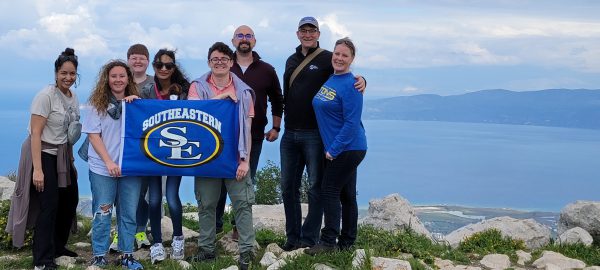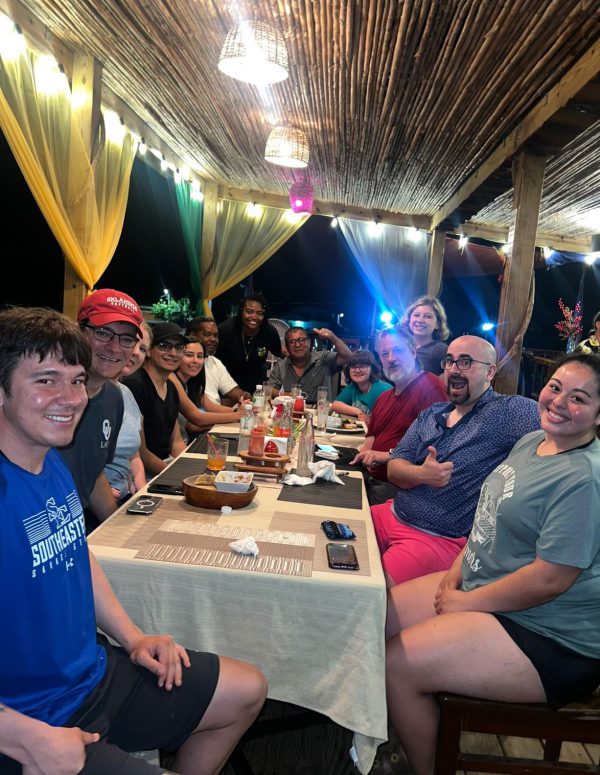More students at Southeastern Oklahoma State University (SEOSU) have applied for passports and are prepared to see the world thanks in part to a Kalamazoo College alumnus inspired by his own study abroad experiences.
Kyle Lincoln ’10 is an associate professor of history at Southeastern Oklahoma State University in Durant, Oklahoma, about 100 miles northeast of Dallas, Texas. He also has been appointed the university’s study abroad director. The university last year had just 14 out of more than 6,000 enrolled students participating in study abroad, but the number overall is trending higher under Lincoln’s watch.
“I can remember starting to talk about going on study abroad when I was a first-year student at K, and now I can talk to our students to plant the idea with them,” Lincoln said. “Someone else then sits near our students in class while saying something like, ‘When I was in Vienna, something amazing happened.’ That’s when students pull the trigger and decide to go. Horizontal marketing like that is pretty powerful for us. And to me, it’s gratifying to know the number of students participating in study abroad here is growing. If we can get it up to about 10% participation, that would be a legacy number for me.”
SEOSU primarily serves students from a 12-county area in the state, all of which consistently rank among the 50 counties in the country with the lowest average household incomes. Additionally, approximately 46% of SEOSU’s students identify as students of color, including about 28% who identify as Native American. Despite these long odds, Southeastern excels in supporting its students through their graduation date and beyond, and consistently ranks in the top 10 universities in the country in graduating Native American students. When Lincoln arrived, there were few opportunities for students to pursue international immersion. Many students come from high-financial-need backgrounds and historically underserved communities, where optional educational opportunities like study abroad were not commonly seen as accessible.
A fledgling study abroad program began about 10 years prior to Lincoln’s arrival, when the honors program director at SEOSU decided that her students needed to see more of the world through short-term study abroad opportunities. Other students were invited along, yet participation stayed low. Lincoln, though, had gained experience leading study abroad programs while teaching at Webster University during graduate school, and he told officials at his new institution that he could dedicate himself to furthering its international immersion efforts.
Lincoln has since helped develop opportunities for full-semester, half-semester and summer-term programs offered through exchange partnerships, federally-funded programs, special fellowships offered by the Oklahoma State Regents for Higher Education, and competitive programs for foreign language study. But much of that development started almost by accident.
“The person who was planning to lead a program to Greece my first year at Southeastern ended up leaving the university,” Lincoln said. “I couldn’t say no when the honors director asked if I wanted to go. From there, we’ve been adding more faculty-led trips. We’ve gone to Belize and Guatemala, and we’re getting ready to go to Spain next year. We went to Iceland this last spring, too. Right now, we have five full-semester programs. I have a proposal on our president’s desk to add about 20 sites in 13 or 14 countries within the next year. That’s a pretty substantial increase in the programs we would be offering, especially for a school that doesn’t really have a dedicated study abroad office except for me.”
Lincoln, who is originally from Ionia, Michigan, said he visited K during high school when Steven Cairns ’93, Ionia’s AP history teacher, encouraged him to do so. The College’s brick-lined streets and trees, which reminded him of home, ultimately helped him decide to attend. As a K student, he took Latin classes and began learning Greek in classics department courses before spending a term abroad in Rome.
He has modeled some of SEOSU’s study abroad structure on his experience at K.
“I remember doing the background work to apply for graduate school and looking at my transcript,” he said. “I noticed I didn’t have separate transcripts from K and from studying abroad. I didn’t think about that for a long time, but it stuck in the back of my head, and we now do something similar at Southeastern. All the students that enroll in study abroad for semester or summer-term programs, enroll in classes that have a prefix of ‘Intl,’ which is international studies with me. Then, as the course codes fluctuate based on what classes they’re taking somewhere else, they stay enrolled at Southeastern despite being at Webster’s campus in Athens or the Universidad Nebrija campus in Madrid. From a practical perspective, that lets them stay on course to graduate. It also keeps enrollment verification for the state of Oklahoma, tribal funders, regional funders, philanthropic organizations or regional scholarships.”



Such a practice helps students maintain their access to university services, too.
“It makes the advising part easy for me, and it also means that the students can, for example, stay in contact with campus health services if they need to because they’re still enrolled with us,” Lincoln said. “They haven’t just gone to another university and enrolled in classes there. One study abroad director horror story I have that had a happy ending: I had a student whose appendix burst while she was in Geneva. Having that happen 4,000 miles from home is scary, but she called me and the campus directors, which allowed us to get some paperwork started. Her biggest complaint by the end? Why was the hospital food in Geneva better than cafeteria food at home!”
As a result, she made a full recovery without any out-of-pocket costs and still benefited from her study abroad experience. Lincoln said it puts students’ minds at ease when they know something about what they can expect and that their school has experience with what to do in emergencies.
The biggest challenge ahead is now building a lasting study abroad culture at SEOSU, which traditionally had students saying, “People like us don’t do that; that’s a rich-kid thing or an East Coast thing.” Lincoln brings to the institution the same belief that was instilled in him at K: that immersive, global experiences should be encouraged and accessible to all students, not just a privileged few.
“The financial challenges are often real for our students, yet building a lasting culture of study abroad at Southeastern has been the bigger challenge,” Lincoln said. “I will tell my students that they go with people they don’t know yet, but I do know them, and we can trust them. There might even be real opportunities abroad they can’t get at our campus or maybe we don’t have the faculty that can give them the variety that they want in their education. There’s also a transformative power in being in the place where something is happening.”
And so far, student feedback after study abroad has been encouraging, indicating the school is ready to ramp up participation.
“At this point, we’re seeing a 100% success rate,” he said. “One hundred percent of the students who go come back and ask questions like, ‘Can I go again? How do I do this forever? Can you tell me what programs for graduate school focus on international education? Is there a way to live abroad and get a master’s degree?’
“I want to make sure my students see study abroad as an opportunity that’s more accessible than they might think and a chance to do something life changing. I want it not to be a question of whether they can go, but when.”

